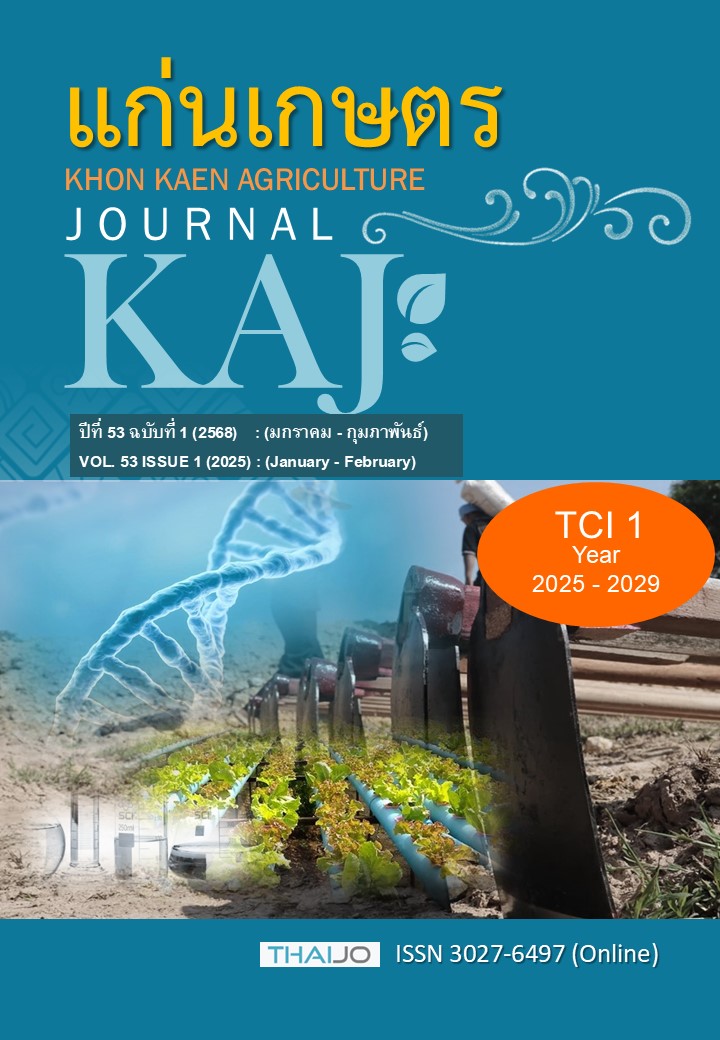Optimum ratio and type of Azolla microphllya with cattle manure for Eudrillus eugeniae growth and vermicompost properties
Main Article Content
Abstract
The purpose of this research was to study the bedding patterns that were suitable for raising earthworms. The experimental design was 2 x 2 x 5 factorial in a completely randomized with 3 replications. Factor 1 was the preparation of bedding (including non-compost (normal) and pre-compost bedding for 15 days), factor 2 was Azolla forms (viz. fresh and dried samples), and factor 3 was the ratio of cow manure and Azolla 10:90, 30:70, 50:50, 70:30 and 90:10 (%v/v). After raising earthworms in bedding for 45 days, the earthworms were separated from the bedding and measured body weight. It was found that earthworms in normal bedding at the ratio of cow manure and fresh Azolla 90:10 and 70:30 had the highest body weight, not being statistically different. In addition, the properties of vermicompost from various bedding were analyzed after raising earthworms for 45 days. The results showed that bedding that had been pre-composted and contained a ratio of cow manure and Azolla at 10:90 presented high amounts of total nitrogen and phosphorus. Therefore, choosing the appropriate form of bedding depends on the production goal of the farmers, whether they want a product of earthworm or vermicompost.
Article Details

This work is licensed under a Creative Commons Attribution-NonCommercial-NoDerivatives 4.0 International License.
References
กรมวิชาการเกษตร. 2563. การจัดการความรู้: เทคโนโลยีการใช้ปุ๋ยชีวภาพเพื่อเพิ่มประสิทธิภาพการผลิตพืชในเขตภาคกลางและภาคตะวันตก. กรมวิชาการเกษตร, กรุงเทพฯ.
จริยา วงศ์ตรี. 2551. วิธีวิเคราะห์ปริมาณฟอสเฟตทั้งหมด. น. 24-28. คู่มือวิธีวิเคราะห์ปุ๋ยอินทรีย์. กลุ่มวิจัยเกษตรเคมี สำนักวิจัยพัฒนาปัจจัยการผลิตทางการเกษตร กรมวิชาการเกษตร, กรุงเทพมหานคร.
จิรายุ นุชนนท์, กนก เลิศพานิช และอภิศักดิ์ โพธิ์ปั้น. 2560. ผลของวัสดุเพาะเลี้ยงที่มีผลต่อจำนวนถุงไข่ น้ำหนักตัว ปริมาณมูลไส้เดือนดินสายพันธุ์ แอฟริกัน ไนท์ ครอเลอร์ (Eudrilus eugeniae). วารสารเกษตรพระจอมเกล้า. 35: 41-48.
ณัฏฐ์ชยธร ขัตติยะพุฒิเมธ และชุลีมาศ บุญไทย อิวาย. 2561. ผลของระยะเวลาการเก็บรักษาต่อคุณภาพของปุ๋ยหมักมูลไส้เดือนดิน. วารสารดินและปุ๋ย. 40: 31-38.
ณินลดา ปานอินทร์. 2551. วิธีวิเคราะห์ความเป็นกรดด่าง. น. 5-6. คู่มือวิธีวิเคราะห์ปุ๋ยอินทรีย์. กลุ่มวิจัยเกษตรเคมี สำนักวิจัยพัฒนาปัจจัยการผลิตทางการเกษตร กรมวิชาการเกษตร, กรุงเทพมหานคร.
นพพร ศิริพานิช. 2563. แหนแดง. น. 7-14. การจัดการความรู้: เทคโนโลยีการใช้ปุ๋ยชีวภาพเพื่อเพิ่มประสิทธิภาพการผลิตพืชในเขตภาคกลางและภาคตะวันตก. สำนักวิจัยและพัฒนาการเกษตรเขตที่ 5 กระทรวงเกษตรและสหกรณื กรมวิชาการเกษตร, กรุงเทพมหานคร.
พีรยุทธ สิริฐนกร, ไกรวิทย์ พะรัมย์ และสุชาดา สานุสันต์. 2557. วัสดุรองพื้นต่างชนิดกันที่มีผลต่อการเจริญเติบโตและผลผลิตปุ๋ยหมักจากไส้เดือนดิน. แก่นเกษตร. 42: 714-721.
พงศ์พิศ แก้วสุข. 2551. วิธีวิเคราะห์ค่าการนำไฟฟ้า น.33-34. คู่มือวิธีวิเคราะห์ปุ๋ยอินทรีย์. กลุ่มวิจัยเกษตรเคมี สำนักวิจัยพัฒนาปัจจัยการผลิตทางการเกษตร กรมวิชาการเกษตร, กรุงเทพมหานคร.
ภฤศญา ปิยนุสรณ์ และวรรณี สุทธใจดี. 2555. การศึกษาการเลี้ยงไส้เดือนเชิงพานิชย์ในการจัดการขยะอินทรีย์. มหาวิทยาลัยราชภัฏสวนสุนันทา, กรุงเทพมหานคร.
รพีพร ชัยชนะ. 2565. ประสิทธิภาพของไส้เดือนดิน Eudrilus eugeniae ในการย่อยสลายเศษอินทรีย์. วารสารมหาวิทยาลัยศรีนครินทรวิโรฒ (สาขาวิทยาศาสตร์และเทคโนโลยี). 14: 142-153.
วรรณรัตน์ ชุติบุตร และชฎาพร คงนาม 2551. วิธีวิเคราะห์โพแทชทั้งหมด. น.29-32. คู่มือวิธีวิเคราะห์ปุ๋ยอินทรีย์. กลุ่มวิจัยเกษตรเคมี สำนักวิจัยพัฒนาปัจจัยการผลิตทางการเกษตร กรมวิชาการเกษตร, กรุงเทพมหานคร.
วรรณรัตน์ ชุติบุตร และสงกรานต์ พระอังคาร. 2551. วิธีวิเคราะห์อินทรียวัตุ อินทรียคาร์บอน อัตราส่วนคาร์บอนต่อไนโตรเจน. น.15-18. คู่มือวิธีวิเคราะห์ปุ๋ยอินทรีย์. กลุ่มวิจัยเกษตรเคมี สำนักวิจัยพัฒนาปัจจัยการผลิตทางการเกษตร กรมวิชาการเกษตร, กรุงเทพมหานคร.
ศิริกุล อ่องกมล และทองจันทร์ พิมพ์เพ็ชร. 2551. วิธีวิเคราะห์ไนโตรเจน. น.19-23. คู่มือวิธีวิเคราะห์ปุ๋ยอินทรีย์. กลุ่มวิจัยเกษตรเคมี สำนักวิจัยพัฒนาปัจจัยการผลิตทางการเกษตร กรมวิชาการเกษตร, กรุงเทพมหานคร.
สำนักควบคุมพืชและวัสดุการเกษตร. 2557. ประกาศกรมวิชาการเกษตร เรื่อง กำหนดเกณฑ์ปุ๋ยอินทรีย์. กรมวิชาการเกษตร, กรุงเทพมหานคร.
Buckingham, K. W., S. W. Ela, J. G. Moris, and C. R. Goldman. 1978. Nutritive value of the Nitrogen-fixing aquatic fern Azolla filiculoides. Journal of Agricultural and Food Chemistry. 26: 1230-1234.
Bocchi, S., and A. Malgioglio. 2010. Azolla-anabaena as a Biofertilizer for Rice Paddy Fields in the Po Valley, a Temperate Rice Area in Northern Italy. International Journal of Agronomy. 1: 1-5.
Edwards, C. A. 2004. Earthworm ecology. 2nd Edition. CRS Press, Florida.
Gajalakshmi, S., and S. A. Abbasi. 2004. Neem leaves as a source of fertilizer-cum-pesticide vermicompost. Bioresource Technology. 92: 29-296.
Lazcano, C., M. Gomez-Brandon, and J. Dominguez. 2008. Comparison of the effectiveness of composting and vermicomposting for the biological stabilization of cattle manure. Chemosphere. 72: 1013–1019.
Ismail, S. A. 1997. Vermicology: The biology of earthworms. Orient Longman Limited, Chennai.
Jayakumar, V., S. S. Murugan, and S. Manivannan. 2018. Biodyanamics of epigeic earthworm Eudrilus eugeniae and Eisenia fetida during recycling of poultry waste amended with different organic food sources. International Archive of Applied Sciences and Technology. 9: 46-51.
Manaf, L. A., M. L. C. Jusoh, M. K. Yusoff, T. H. T. Ismail, R. Harun, and H. Juahir. 2009. Influences of beeding material in vermicomposting process. International Journal of Biology. 1: 81-91.
Manaig, E. M. 2016. Vermicomposting efficiency and quality of vermicompost with different bedding materials and worm food sources as substrate. Research Journal of Agriculture and Forestry Sciences. 4: 1-13.
Matney, C. 2018. Composting with worms. Available: https://yakutattlingittribe.org/wp-content/uploads/ 2019/12/ Composting-with-Worms.pdf. Accessed Jan.14, 2024.
Nam, K. W., and D. H. Yoon. 2008. Usage of Azolla spp. as a biofertilizer on the environmental-friendly agriculture. Korean Journal of Plant Research. 21: 230-235.
Ro, S., V. Long, R. Sor, S. Pheap, R. Nget, and J. William. 2022. Alternative feed sources for vermicompost production. Environment and Natural Resources Journal. 20: 393-399.
Reiling, B. 2022. Feed dry matter conversions. Available: https://extensionpubs.unl.edu/publication/g2093/na/html/view. Accessed Aug.17, 2024.
Tangsombatvichit, P., S. Chupong, D. Ketrot, and K. Boonlerthirun. 2016. The management of organic wastes produced vermicompost using earthworm Eudrilus eugeniae and effects of vermicompost on growth of Helianthus annuus. 5th International conference on food, Agricultural and Biological Sciences (ICFABS-2016), Dec 25-26, 2016, Thailand.
Vodounnou, D. S. J. V., D. N. S. Kpoque, C. E. Tossavi, G. A. Mennsah, and E. D. Flogbe. 2016. Effect of animal waste and vegetable compost on production and growth of earthworm (Eisenia fetida) during vermiculture. International Journal of Recycling of Organic Waste in Agriculture. 5: 87-92.
Watanabe, I., and C. Ramirez. 1990. Phosphorus and nitrogen contents of Azolla grown in the Philippines. Soil Science and Plant Nutrition. 36: 319-331.

